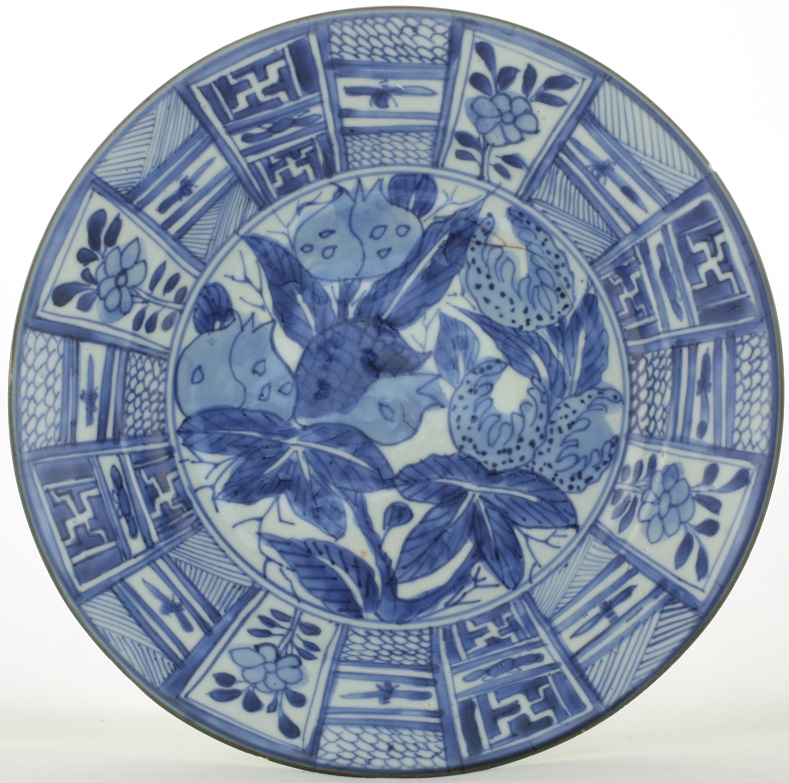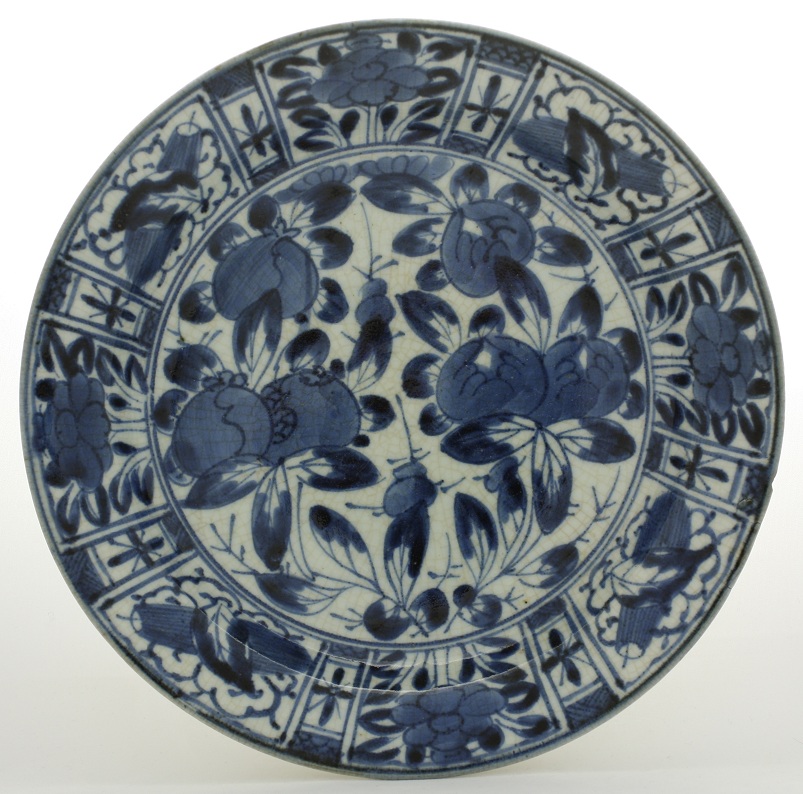
Sold Ceramics - Sold Blue and White wares since 1722 - Dishes - Page 1
Object 2011416
Dish
China
c.1725
Height 35 mm (1.38 inch), diameter of rim 218 mm (9.45 inch), diameter of footring 120 mm (4.84 inch), weight 298 grams (10.51 ounce (oz.))
Dish on footring, flat underglaze brown-edged rim (jia mangkou). Decorated in underglaze blue Chinese kraak style with two branches with fruit, one with pomegranates and one with finger-lemon fruit also called 'Buddha's-hand citron' (Citrus medica). The interior wall is divided into panels filled with swastika, scale-pattern, zig-zag lines and flowers. The reverse is undecorated.
The dish shows a simplified kraak decorative arrangement. Both decorative elements, pomegranates and 'Buddha's-hand citron' (Citrus medica), can also be found on Japanese blue and white Arita dishes from the Edo early period (1615-1703), c.1660-1680. Although the decoration on this dish is reminiscent of kraak, the undecorated reverse, is not.

Object 2010231, Dish, Japan, Arita presumably Sarugawa, 1670-1690 (not included in this offer/sale).
In the cargo of the Ca Mau shipwreck, c.1725 a series of five, identically decorated, dishes were found together with a series of dishes decorated with the Chine de commande 'Scheveningen design'. Both original designs were traditionally made in Arita Japan 1660-1710 for the Dutch. These dishes were so popular that Chinese potters copied them in order to compete with the Japanese. Such copies were already known, but the occurrence in the Ca Mau made it likely that these dishes that these dishes, and therefore most of the porcelain cargo, were destined for Batavia because only the Dutch would appreciate such specific Chine de commande pieces. (Amsterdam 2007, p.17 & p.179)
In 1675 rebel armies swept across Jingdezhen, burning the greater part of kilns in the area to the ground. Five years later the Kangxi Emperor controlled the southern provinces, thus uniting China under his rule. In 1680 the young Emperor expressed his personal interest in the industry of the region by appointing a commission to study the problem of how best to rebuild the ceramic industry in the Jingdezhen area. Trade with the Dutch resumed in 1681. In 1682 the first of a series of able superintendents was appointed to establish and direct a kiln complex organized on an industrial basis which enjoyed Imperial patronage. A few decades after the restoration of the Jingdezhen kilns, some porcelains were still decorated with the kraak motifs which had been so popular during the late Ming Dynasty. Kraak copies produced at Jingdezhen during the last twenty years of the seventeenth century and the first decades of the eighteenth century no longer have grit adhering to the footring or chatter marks on the bases. Rims are not foliate but straight or carefully scalloped with the glaze adhering perfectly without forming the moth-eaten edge so typical for earlier Kraak wares. (Rinaldi 1989, pp.230-232, Pl.293)
The pomegranate, Punica granata, is a Buddhist sign. The fruit is supposed to represent the essence of the favourable influence believed to exist in the pomegranate tree. A twig of the pomegranate is sometimes used instead of willow for sprinkling water. The pomegranate, as in ancient Greece, is, also owing to its numerous seeds, an emblem of posterity. (Williams 1976, pp.332-333)

The 'Fingered citron or Buddha's hand' (Citrus medica) is a small, open citrus with distinctive fruit, native to the foothills of the Himalayas. Around 320 BC, Greeks and Romans used the fruit as a source of fragrance and the leaves as a moth repellent. The fruit has also been used for centuries to perfume clothes and rooms, as ornaments in religious ceremonies and is appreciated for its medicinal qualities. This explains why the Chinese treated it as a precious decorative object in the old days. When the pomegranate ripens it opens up and exposes lots of seeds inside. Chinese people like its pretty appearance, signifying many offspring /children to come. (I am indebted to Mr S. Fan for this information)
For similarly decorated Chinese dishes, please see:
For identically in Chinese kraak style decorated, original Japanese, Edo early period dishes for sale, please see:
Japanese Blue and White wares 17th Century - Dishes - Page 1 - Object 2010231.
Japanese Blue and White wares 17th Century - Dishes - Page 1 - Object 2010437.
For other identically in Chinese kraak style decorated, original Japanese, Edo early period dishes, please see:
- Japans porselein met blauwe decoraties uit de tweede helft van de zeventiende en de eerste helft van de achttiende eeuw, (D.F. Lunsingh Scheurleer, in, Mededelingenblad Nederlandse Vereniging van Vrienden van de Ceramiek, vols. 64/65, 1971), p.54, cat. 8.
- Pronken met Oosters porselein, exhibition catalogue Gemeente Museum Arnhem, (S. Hartog, Waanders, Zwolle 1990), p.128, cat. 153.
- Japanese Export Porcelain. Catalogue of the Collection of the Ashmolean Museum, Oxford, (O. Impey, Hotei Publishing, Amsterdam, 2002), p.109, cat. 128.
- Fine & Curious: Japanese Export Porcelain in Dutch Collections, (C.J.A. Jörg, Hotei Publishing, Amsterdam 2003), p.28, cat. 8.
Condition: A firing flaw, a frit and a chip to the rim. A hairline and a firing flaw with two connected hairlines to the base.
References:
Lunsingh Scheurleer 1971, cat. 8
Price: Sold.


 create websites
create websites